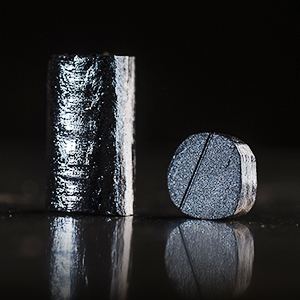 | ||
Samarium hexaboride (SmB6) is an intermediate-valence compound where samarium is present both as Sm2+ and Sm3+ ions at the ratio 3:7. It belongs to a class of Kondo insulators.
At temperatures above 50 K its properties are typical of a Kondo metal, with metallic electrical conductivity characterized by strong electron scattering, whereas at low temperatures, it behaves as a non-magnetic insulator with a narrow band gap of about 4–14 meV.
The cooling-induced metal-insulator transition in SmB6 is accompanied by a sharp increase in thermal conductivity, peaking at about 15 K. The reason for this increase is that electrons do not contribute to thermal conductivity at low temperatures, which is instead dominated by phonons. The decrease in electron concentration reduced the rate of electron-phonon scattering.
New research seems to show that it may be a topological insulator.
Its electrical resistance indicates that the material behaves as an insulator; however, its Fermi surface (an abstract boundary used to reliably predict the properties of materials) contradicts this, indicating that the material actually behaves as a good metal. At temperatures approaching absolute zero, the quantum oscillations of the material grow as the temperature declines, a behavior that contradicts both the Fermi analysis and the rules that govern conventional metals.
